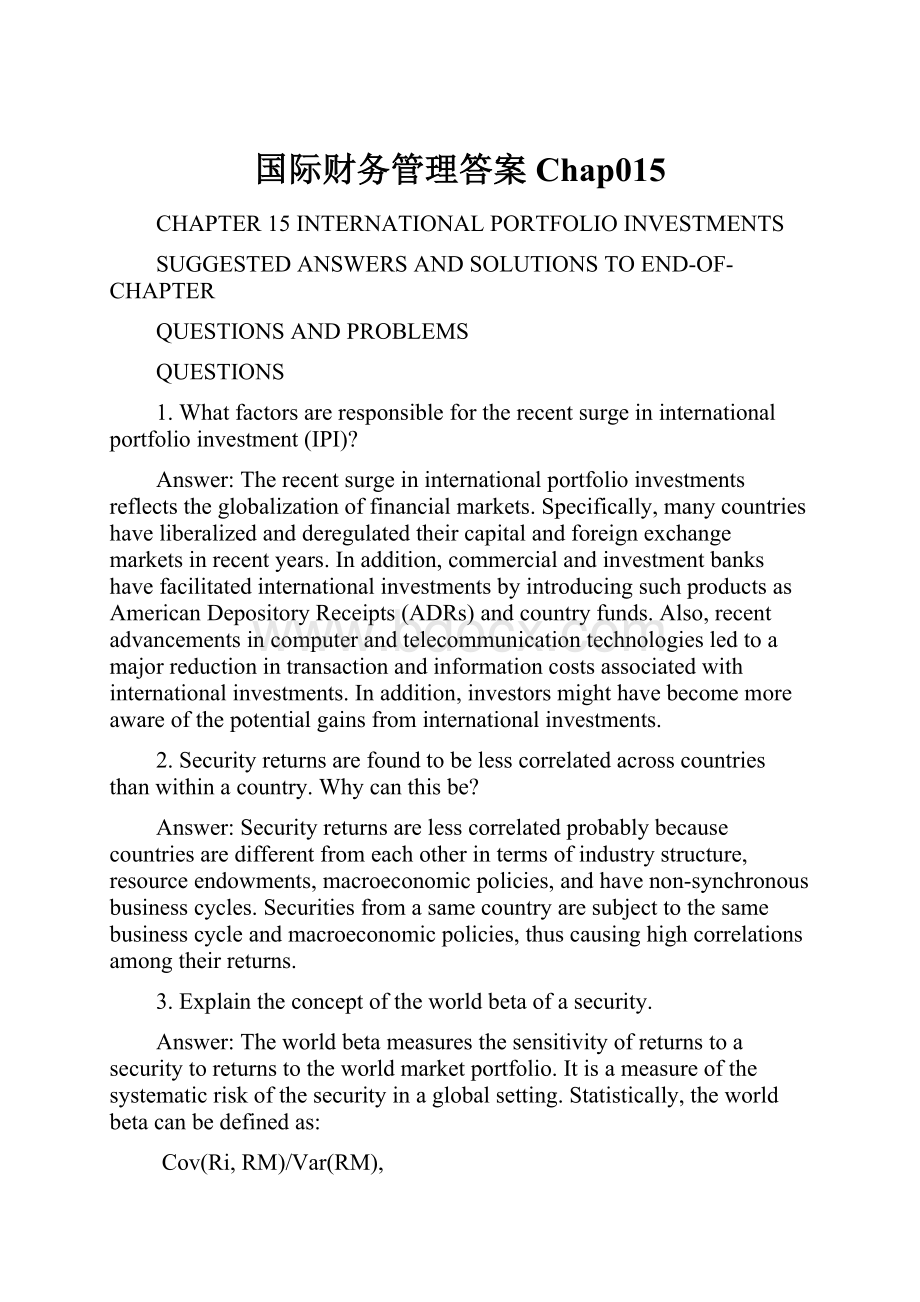 国际财务管理答案Chap015.docx
国际财务管理答案Chap015.docx
- 文档编号:24025747
- 上传时间:2023-05-23
- 格式:DOCX
- 页数:13
- 大小:30.99KB
国际财务管理答案Chap015.docx
《国际财务管理答案Chap015.docx》由会员分享,可在线阅读,更多相关《国际财务管理答案Chap015.docx(13页珍藏版)》请在冰豆网上搜索。

国际财务管理答案Chap015
CHAPTER15INTERNATIONALPORTFOLIOINVESTMENTS
SUGGESTEDANSWERSANDSOLUTIONSTOEND-OF-CHAPTER
QUESTIONSANDPROBLEMS
QUESTIONS
1.Whatfactorsareresponsiblefortherecentsurgeininternationalportfolioinvestment(IPI)?
Answer:
Therecentsurgeininternationalportfolioinvestmentsreflectstheglobalizationoffinancialmarkets.Specifically,manycountrieshaveliberalizedandderegulatedtheircapitalandforeignexchangemarketsinrecentyears.Inaddition,commercialandinvestmentbankshavefacilitatedinternationalinvestmentsbyintroducingsuchproductsasAmericanDepositoryReceipts(ADRs)andcountryfunds.Also,recentadvancementsincomputerandtelecommunicationtechnologiesledtoamajorreductionintransactionandinformationcostsassociatedwithinternationalinvestments.Inaddition,investorsmighthavebecomemoreawareofthepotentialgainsfrominternationalinvestments.
2.Securityreturnsarefoundtobelesscorrelatedacrosscountriesthanwithinacountry.Whycanthisbe?
Answer:
Securityreturnsarelesscorrelatedprobablybecausecountriesaredifferentfromeachotherintermsofindustrystructure,resourceendowments,macroeconomicpolicies,andhavenon-synchronousbusinesscycles.Securitiesfromasamecountryaresubjecttothesamebusinesscycleandmacroeconomicpolicies,thuscausinghighcorrelationsamongtheirreturns.
3.Explaintheconceptoftheworldbetaofasecurity.
Answer:
Theworldbetameasuresthesensitivityofreturnstoasecuritytoreturnstotheworldmarketportfolio.Itisameasureofthesystematicriskofthesecurityinaglobalsetting.Statistically,theworldbetacanbedefinedas:
Cov(Ri,RM)/Var(RM),
whereRiandRMarereturnstothei-thsecurityandtheworldmarketportfolio,respectively.
4.ExplaintheconceptoftheSharpeperformancemeasure.
Answer:
TheSharpeperformancemeasure(SHP)isarisk-adjustedperformancemeasure.Itisdefinedasthemeanexcessreturntoaportfolioabovetherisk-freeratedividedbytheportfolio’sstandarddeviation.
5.Explainhowexchangeratefluctuationsaffectthereturnfromaforeignmarketmeasuredindollarterms.Discusstheempiricalevidenceontheeffectofexchangerateuncertaintyontheriskofforeigninvestment.
Answer:
ItisusefultorefertoEquations11.4and11.5ofthetext.Exchangeratefluctuationsmostlycontributetotheriskofforeigninvestmentthroughitsownvolatilityaswellasitscovariancewiththelocalmarketreturns.Thecovariancetendstobepositiveinmostofthecases,implyingthatexchangeratechangestendtoaddtoexchangerisk,ratherthanoffsetit.Exchangeriskisfoundtobemuchmoresignificantinbondinvestmentsthaninstockinvestments.
6.Wouldexchangeratechangesalwaysincreasetheriskofforeigninvestment?
Discusstheconditionunderwhichexchangeratechangesmayactuallyreducetheriskofforeigninvestment.
Answer:
Exchangeratechangesneednotalwaysincreasetheriskofforeigninvestment.Whenthecovariancebetweenexchangeratechangesandthelocalmarketreturnsissufficientlynegativetooffsetthepositivevarianceofexchangeratechanges,exchangeratevolatilitycanactuallyreducetheriskofforeigninvestment.
7.Evaluateahomecountry’smultinationalcorporationsasatoolforinternationaldiversification.
Answer:
DespitethefactthatMNCshaveoperationsworldwide,theirstockpricesbehaveverymuchlikepurelydomesticfirms.Thisispuzzlingyetundeniable.Asaresult,MNCsareapoorsubstitutefordirectforeignportfolioinvestments.
8.Discusstheadvantagesanddisadvantagesofclosed-endcountryfunds(CECFs)relativetotheAmericanDepositoryReceipts(ADRs)asameansofinternationaldiversification.
Answer:
CECFscanbeusedtodiversifyintoexoticmarketsthatareotherwisedifficulttoaccesssuchasIndiaandTurkey.Beingaportfolio,CECFsalsoprovideinstantdiversification.ADRsdonotprovideinstantdiversification;investorsshouldformportfoliosthemselves.Inaddition,therearerelativelyfewADRsfromemergingmarkets.ThemaindisadvantageofCECFsisthattheirsharepricesbehavesomewhatlikethehostcountry’sshareprices,reducingthepotentialdiversificationbenefits.
9.Whydoyouthinkclosed-endcountryfundsoftentradeatapremiumordiscount?
Answer:
CECFstradeatapremiumordiscountbecausecapitalmarketsofthehomeandhostcountriesaresegmented,preventingcross-borderarbitrage.Ifcross-borderarbitrageispossible,CECFsshouldbetradingneartheirnetassetvalues.
10.Whydoinvestorsinvestthelion’sshareoftheirfundsindomesticsecurities?
Answer:
Investorsinvestheavilyintheirdomesticsecuritiesbecausetherearesignificantbarrierstoinvestingoverseas.Thebarriersmayincludeexcessivetransactioncosts,informationcostsforforeignsecurities,legalandinstitutionalrestrictions,extrataxes,exchangeriskandpoliticalriskassociatedwithoverseasinvestments,etc.
11.Whataretheadvantagesofinvestingviainternationalmutualfunds?
Answer:
Theadvantagesofinvestingviainternationalmutualfundsinclude:
(1)savetransaction/informationcosts,
(2)circumventlegal/institutionalbarriers,and(3)benefitfromtheexpertiseofprofessionalfundmanagers.
12.Discusshowtheadventoftheeurowouldaffectinternationaldiversificationstrategies.
Answer:
Astheeuro-zonewillhavethesamemonetaryandexchange-ratepolicies,thecorrelationsamongeuro-zonemarketsarelikelytogoup.Thiswillreducediversificationbenefits.However,totheextentthattheadoptionofeurostrengthenstheEuropeaneconomy,investorsmaybenefitfromenhancedreturns.
PROBLEMS
1.Supposeyouareaeuro-basedinvestorwhojustsoldMicrosoftsharesthatyouhadboughtsixmonthsago.Youhadinvested10,000eurostobuyMicrosoftsharesfor$120pershare;theexchangeratewas$1.15pereuro.Yousoldthestockfor$135pershareandconvertedthedollarproceedsintoeuroattheexchangerateof$1.06pereuro.First,determinetheprofitfromthisinvestmentineuroterms.Second,computetherateofreturnonyourinvestmentineuroterms.Howmuchofthereturnisduetotheexchangeratemovement?
Solution:
Itisusefulfirsttocomputetherateofreturnineuroterms:
C
Thisindicatesthatthiseuro-basedinvestorbenefitedfromanappreciationofdollaragainsttheeuro,aswellasfromanappreciationofthedollarvalueofMicrosoftshares.TheprofitineurotermsisaboutC2,100,andtherateofreturnisabout21%ineuroterms,ofwhich8.5%isduetotheexchangeratemovement.
2.Mr.JamesK.Silber,anavidinternationalinvestor,justsoldashareofNestlé,aSwissfirm,forSF5,080.ThesharewasboughtforSF4,600ayearago.TheexchangerateisSF1.60perU.S.dollarnowandwasSF1.78perdollarayearago.Mr.SilberreceivedSF120asacashdividendimmediatelybeforethesharewassold.ComputetherateofreturnonthisinvestmentintermsofU.S.dollars.
Solution:
Mr.Silbermusthavepaid$2,584.27(=4,600/1.78)forashareofNéstleayearago.Whenthesharewasliquidated,hemusthavereceived$3,250[=(5,080+120)/1.60].Therefore,therateofreturnindollartermsis:
R($)=[(3,250-2,584.27)/2584.27]x100=25.76%.
3.Intheaboveproblem,supposethatMr.SilbersoldSF4,600,hisprincipalinvestmentamount,forwardattheforwardexchangerateofSF1.62perdollar.HowwouldthisaffectthedollarrateofreturnonthisSwissstockinvestment?
Inhindsight,shouldMr.SilberhavesoldtheSwissfrancamountforwardornot?
Whyorwhynot?
Solution:
ThedollarprofitfromsellingSF4,600forwardisequalto:
Profit($)=4,600(1/1.62–1/1.60)
=4,600(0.6173–0.625)
=-$35.42.
Thus,thetotalreturnofinvestmentis:
R($)=[(3,250-2,584.27-35.42)/2584.27]x100=24.39%.
By‘hindsight’,Mr.SilbershouldnothavesoldtheSFamountforwardasitreducedthereturnindollarterms.
4.JapanLifeInsuranceCompanyinvested$10,000,000inpure-discountU.S.bondsinMay1995whentheexchangeratewas80yenperdollar.Thecompanyliquidatedtheinvestmentoneyearlaterfor$10,650,000.Theexchangerateturnedouttobe110yenperdollaratthetimeofliquidation.WhatrateofreturndidJapanLiferealizeonthisinvestmentinyenterms?
Solution:
JapanLifeInsuranceCompanyspent¥800,000,000tobuy$10,000,000thatwasinvestedinU.S.bonds.Theliquidationvalueofthisinvestmentis¥1,171,500,000,whichisobtainedfrommultiplying$10,650,000by¥110/$.Therateofreturnintermsofyenis:
[(¥1,171,500,000-¥800,000,000)/¥800,000,000]x100=46.44%.
5.Atthestartof1996,theannualinterestratewas6percentintheUnitedStatesand2.8percentinJapan.Theexchangeratewas95yenperdollaratthetime.Mr.Jorus,whoisthemanagerofaBermuda-basedhedgefund,thoughtthatthesubstantialinterestadvantageassociatedwithinvestingintheUnitedStatesrelativetoinvestinginJapanwasnotlikelytobeoffsetbythedeclineofthedollaragainsttheyen.HethusconcludedthatitmightbeagoodideatoborrowinJapanandinvestintheUnitedStates.Atthestartof1996,infact,heborrowed¥1,000millionforoneyearandinvestedintheUnitedStates.Attheendof1996,theexchangeratebecame105yenperdollar.HowmuchprofitdidMr.Jorusmakeindollarterms?
Solution:
LetusfirstcomputethematurityvalueofU.S.investment:
(¥1,000,000,000/95)(1.06)=$11,157,895.
Thedollaramountnecessarytopayoffyenloanis:
(¥1,000,000,000)(1.028)/105=$9,790,476.
Thedollarprofit=$11,157,895-$9,790,476=$1,367,419.
Mr.JoruswasabletorealizealargedollarprofitbecausetheinterestratewashigherintheU.S.than
- 配套讲稿:
如PPT文件的首页显示word图标,表示该PPT已包含配套word讲稿。双击word图标可打开word文档。
- 特殊限制:
部分文档作品中含有的国旗、国徽等图片,仅作为作品整体效果示例展示,禁止商用。设计者仅对作品中独创性部分享有著作权。
- 关 键 词:
- 国际 财务管理 答案 Chap015
 冰豆网所有资源均是用户自行上传分享,仅供网友学习交流,未经上传用户书面授权,请勿作他用。
冰豆网所有资源均是用户自行上传分享,仅供网友学习交流,未经上传用户书面授权,请勿作他用。


 《公务员财产申报制度》.docx
《公务员财产申报制度》.docx
